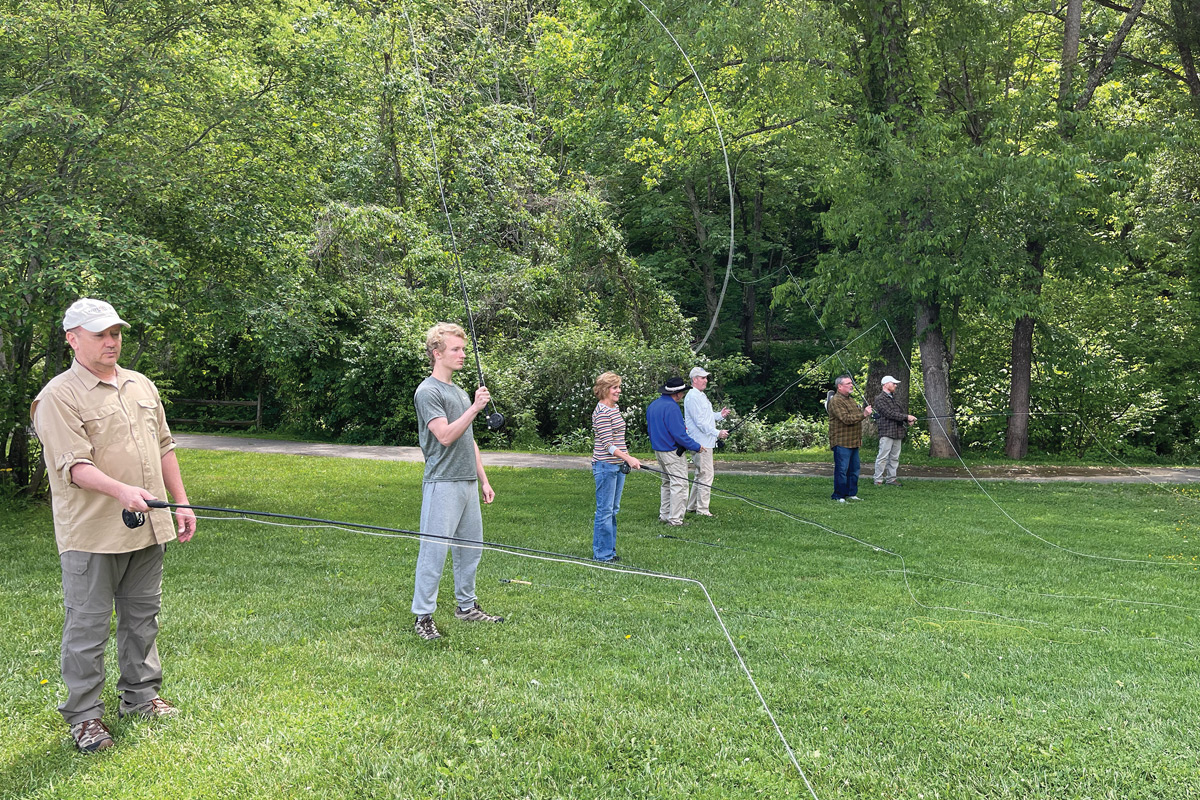Wading in: An inside look at Haywood County’s fly fishing class
 Participants practiced casting, learning how to let the fly drift down to the water in a way that will have the fish biting in the future.
Kyle Perrotti
Participants practiced casting, learning how to let the fly drift down to the water in a way that will have the fish biting in the future.
Kyle Perrotti
When my wife told me she’d signed me up for a fly-fishing class, I probably let out an audible groan. I almost didn’t go — hell, Friday is usually my day to stay home and write. Why infringe on that?
I’ve always liked hiking in the Smokies, but who has the focus to stand in one place and flick a line around? I grew up fishing rivers in Washington state and have enjoyed it here and there in my adult life, but those ventures were the classic “set it and forget it,” a chance to enjoy some beer and idle conversation between tugs on the line.
But my wife figures fly fishing is a pastime that would probably suit me. Her underlying motivation may have been that the man who leads the class, Tommy Thomas, sells fly rods at the gallery she manages, Waynesville’s Twigs and Leaves. Thomas is a favorite of the gallery, and Tiffani always wants me to meet the people she respects. She arranged it so I would take the class with the gallery’s owner, Roger Reid, and his next-door neighbor, Station on Main owner Kirk Noonan, as well as Dennis and Graham Hysom, the husband and son of Tiffani’s coworker, Lenora.
The first of two days, I arrived in the small, empty parking lot off Richland Creek near the Lake Junaluska Golf Course. As I sat eating my biscuit and sipping my coffee, I side eyed the geese, and the geese side eyed me. We’ve never gotten along, and there was an uneasy tension.
Roger pulled up next to me as I crumpled up the Chick Fil A bag and tossed it in my back seat. We chatted as a mother goose wobbled up with a few goslings behind her, a developing threat. A few minutes later, Dennis and Graham arrived, and then a woman named Cindy. We stood in the parking lot and chatted for probably a half hour when Roger finally said what we were all thinking.
“Maybe we’re in the wrong place?”
Related Items
I followed the others who drove with a strong sense of purpose to the Waynesville Recreation Park — the other side of the Richland Creek Greenway — where we encountered Thomas and the others. I was nervous about what I may have missed, partly because I wanted to make the most of the time and really learn the basics of fly fishing, but mostly because it sucks to write a story after feeling like you missed something.
Thomas welcomed us with no hesitation, and we set up our lawn chairs around a table displaying a bunch of books and some random fly-fishing equipment. Going clockwise around our little semicircle, we introduced ourselves. Once Thomas got to me, he excitedly spoke about my former coworker Holly Kays, who’d previously written about the class.
“I used to work with Holly Kays; she’s just a fantastic writer,” he exclaimed.
I chuckled to myself. He wasn’t wrong, but the pressure was on. Once the class began in earnest, I scribbled notes as other eager aspiring anglers did the same.
The class began with Thomas giving everyone his business card, not for self-promotion but to provide a vital resource for the future. As I’ve since learned, exploring the vast world of rods and reels and gadgets and gizmos can be overwhelming, so Thomas encouraged everyone to give him a call any time they have questions.
“Once you’re my students, you’re my students for life,” he told the class.
Thomas, absurdly spry for a 76-year-old, is not only an expert fly fisherman; he’s also an avid educator, a storyteller and a sort of modern-day philosopher. Clad in an array of gear ornamented with various flies and gear, he embodied what many in the group aspired to. He began by informing the students that they live in “fly fishing Mecca,” a beautiful place with pristine waters and plenty of trout. But that’s not what’s it’s about, Thomas said, invoking a famous Henry David Thoreau quote: “Many men go fishing their entire lives without knowing it isn’t the fish they’re after.”
Thomas estimated 95% have yet to reach the enlightenment Thoreau references.
“Once you cross over to the 5%, you’ll know what this sport is all about,” Thomas said.
And it’s the solitude he referenced, a chance to think clearly and honestly amid nature, which passes no judgment. Us students, there to learn the basics, were eager to experience what still may seem like an abstract concept.
When it came to the nuts and bolts, Thomas threaded humor and trivia throughout the lessons to keep people engaged. While he taught introductory techniques and explained the basic equipment, he also built in everyone a feeling of comfort and confidence. He offered the words of another great philosopher, who, when teaching a reluctant student said, “Do or do not. There is no try.” That philosopher, as some in the class seemed to know based on their quiet smiles, was Yoda.
But the message was real, and Thomas spent real time telling everyone that they can do this and do it well; it’s just a matter of repetition. Even when it came to tying flies, the part of the fly fishing that still feels most elusive to me, he offered encouragement — they don’t have to be pretty, he said.
“The fish will meet you halfway,” he said. “Don’t worry about it.”
That first day, we also practiced casting without flies, which was for the best, considering most of us were flinging our lines around and no doubt would have hooked a limb — tree or human — at some point. The mechanics were simple, bring your elbow right into your side and move your arm from 10 o’clock to 2 o’clock. Pay special attention to not throw the line as you would casting with a traditional rod and reel, but rather let the motion of the line drive things. The second you feel the weight shift back on the rod, move your arm forward and let the line drift down elegantly. More complex casts will come later, Thomas assured.
The next Friday was similar, with some time spent practicing casting and plenty dedicated to stream etiquette and navigating safety hazards, including falls, hypothermia, stolen equipment, parasitic microorganisms, snakes, bears, elk, drowning and sudden bad weather.
“Did I scare you off from fly fishing yet?” Thomas joked.
The group also ventured down to Richland Creek, so Thomas could point out the basics of reading the water, where to cast and how to let a fly drift. He even waded down into the creek to point out the nymphs that hide under the rocks.
At the end, Thomas donned his full getup, complete with waders and a fishing vest loaded with all kinds of stuff, including a pipe and tobacco. Ending the class with a gear breakdown was perfect — it showed everyone what it’s supposed to look like. Once all was said and done, everyone had all the knowledge they needed to at least get out on the water, and that’s what it’s all about.
I interviewed Thomas after the end of the second day, during which he spoke a bit about his pedagogical philosophy. While he’s been teaching this class for about five years, education has been a lifelong interest of his, even throughout his career which brought him to teaching construction management. He agreed that perhaps the most important thing is letting people know they can learn this great new hobby, no matter where they are in life.
“Everybody can do this,” he said. “I touched on every aspect of fly fishing to make sure that you were exposed to it, that you learn from it. I've had over probably 500 or 600 students come through here, anywhere from seven years old up to 85 years old, all who have just started out in it. They all learned that yes, you can do this.”
Thomas said many of his students do take to fly fishing and have come to realize that one of the truest joys is in the continuous learning and development inherent to the sport. Thomas, who himself has mastered the crafts of fly tying and bamboo rod refurbishment understands this concept well, and he’s also created his own trademark knot and fly cast — the aptly titled Tommy Knot and Tommy Cast.
“There’s no question about it, this is individualistic,” he said. “You get your favorite rod, your favorite fly and all that, and everything becomes second nature. It’s an extension of your arm. There's no right or wrong. It's just whatever you want to do yourself.”
This is similar to my view of writing. Fly fishing, like writing, is a craft. The goal is never to be perfect, it’s to always improve, always seek the next plateau. Finding your own innovations along the way is the treat. And so here I sit, having now purchased all the basic gear — cheap stuff that can be replaced as the need arises, as Tommy recommended — ready to give this thing a go. Like most times I feel hesitant about diving into something, whether because of anxiety or simply because I feel like I have other things to be doing, I am glad I showed up, and I plan to stick with this.
See you in the stream.
Haywood County Recreation offers beginner and intermediate fly fishing courses, as well as expeditions, each for $10. Visit secure.rec1.com/NC/haywood-county-nc/catalog for schedules and details.
Fly Fishing and Outdoors Festival
Maggie Valley is set to host the second annual Fly Fishing and Outdoors Festival June 15 and 16.
The event will offer plenty for anglers of all levels, including those who are interested but have perhaps never flung a fly. The aim is both to bring awareness to the sport so many in the region love and also to expose more experienced anglers to the latest and greatest.
This year, the event will feature over 80 vendors. Local flyfishing legend Tommy Thomas noted that it will be the largest in North Carolina.
“Some of the top rod makers in the world are going to be at this festival,” Thomas said. “Also, people that I know who build bamboo fly rods from scratch are going to be at the festival as well.”
In addition, women’s world champion fly fisherman, Jule Mattson, will attend. Mattson will even teach classes.
“They're actually going to be taking people down on the water and learning,” Thomas said. “She's going to teach them techniques.”
There will also be fly tying classes, additional clinics to teach casting and other techniques, food vendors and fun competitions.
For more information, visit maggievalleyflyfishingfestival.com.









